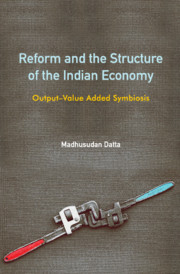Book contents
- Frontmatter
- Dedication
- Contents
- Tables
- Figures and Box
- Preface
- 1 Introduction: The Take-off
- 2 Growth and Structural Change since 1978–79: Issues in Measurement
- 3 Sectoral Shares in Indian GDP: How to Regard It?
- 4 Sectoral Growth: GVA–Output Dichotomy
- 5 Manufacturing Sector in the Indian Economy: Paradox of Growth and Stagnation
- 6 Growth and Sectoral GVA Adjustments
- 7 Demand for Intermediate Services
- 8 Linkages and Key Sectors in the Indian Economy
- 9 Conclusion: A Perspective of Indian Economic Growth
- References
- Index
1 - Introduction: The Take-off
Published online by Cambridge University Press: 17 March 2020
- Frontmatter
- Dedication
- Contents
- Tables
- Figures and Box
- Preface
- 1 Introduction: The Take-off
- 2 Growth and Structural Change since 1978–79: Issues in Measurement
- 3 Sectoral Shares in Indian GDP: How to Regard It?
- 4 Sectoral Growth: GVA–Output Dichotomy
- 5 Manufacturing Sector in the Indian Economy: Paradox of Growth and Stagnation
- 6 Growth and Sectoral GVA Adjustments
- 7 Demand for Intermediate Services
- 8 Linkages and Key Sectors in the Indian Economy
- 9 Conclusion: A Perspective of Indian Economic Growth
- References
- Index
Summary
No power on earth can stop an idea whose time has come.
—Manmohan Singh, quoting Victor Hugo, in his budget speech on 24 July 1991The Historical Background
At Independence in 1947, India was a laggard by far, more than a hundred years, compared to the advanced countries of the time, led by the United States and the United Kingdom. The preindustrial level of per capita income of the developed countries was several times higher than that of the mid-twentieth-century underdeveloped countries, of which the classic examples were India and China. These great old civilizations remained unaffected by the reverberations of economic and technological revolutions that started in the late eighteenth century in Europe – changes that define much of the content of modern economic development. Almost two centuries of subjugation by an aggressive Western power distorted the country's internal organization, both economic and social. However, it did leave a heritage of having sown the seeds of a democratic political system, complete with an entrenched legal framework and a structure for modern education. This brought India to the moment ‘when the age ends, and when the soul of a nation, long suppressed, finds utterance’. What was the state of the Indian countryside at that time? A picturesque description is given by a British civil servant E. H. H. Edye for the period between the two world wars: ‘Bicycles appeared in every village, electric torches and cigarettes; it became a custom to drink tea, a thing unknown among the peasants before 1914. This was material progress’ (Mason, 1985: 278). Three-fourths of the labour force was engaged in agriculture, but the country's social milieu had a fine upper crust of extremely well-educated Indians while the illiteracy level was 83 per cent.
At that time, India had a small but eminently capable and spirited group of entrepreneurs. However, central planning, in one way or the other, caught the fancy of many, including the new government of independent India, with its strong inclinations towards Fabian socialism. A few initial years post Independence were spent in bringing the house to order after the terrible events and all-round mess created by the partition of the country. The real development efforts started with the Second Five Year Plan. The spirit underlying the strategy had a link to the idea of swadeshi, which was the rallying cry of the Independence movement in the early decades of the twentieth century and, thus, ingrained in the national mindset.
- Type
- Chapter
- Information
- Reform and the Structure of the Indian EconomyOutput-Value Added Symbiosis, pp. 1 - 16Publisher: Cambridge University PressPrint publication year: 2020



